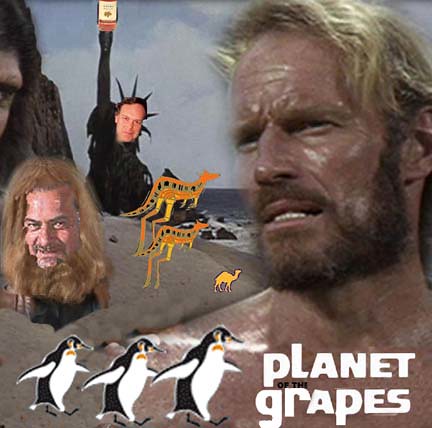
Planet of the Grapes
Part 1: The Domination
It happened slowly, methodically, and then with machine like precision.
The domination started with corporate consolidation. Vineyards were snapped up and eventually whole regions were divided amongst 4 or 5 companies. Philip Morris had long bought out Constellation, Fosters by Monsanto. Coke, too, had important holdings. Corporate efficiency combined with technological innovation, fastidious marketing and a monopoly on distribution slowly squeezed out the independents.
And the technology had changed. Two hybrid vines, nicknamed the white and red camel were capable of growing in sand, and vast tracts of previously drought-ridden lands were subsequently irrigated and fertilized. The goal was quantity and did they ever produce. China, and a number of African nations had become leading grape juice producers. As arable land was becoming scarce in much of Europe and North America, conglomerates uprooted their local vines in deference to these more cost-efficient camel vines.
While certain aromas, and a variety of fruit and wood flavors had been synthesized in the first decade of the 21st Century, new developments had allowed the wine giants to synthesize varietal characteristics, making the need for thousands of grape types redundant (although in reality 95% of consumers already seemed satisfied by a choice between a dozen varietals).
Thus one red and one white in the field had become the industry standard; the rest of the work was done during ‘conversion,’ where technicians watched over the vinitoriums, home to massive steel fermenting resevoirs. Interspersed amongst these refineries were laboratories whose task was to produce the acids, yeasts, tannins, sweeteners and enzymes necessary to turn the camel juice into wine.
One exciting, recent innovation was the ability to synthesize terroir. Unlocking this mystery had allowed for the marketers to offer the consumer, thirsty for even an implied distinction, variations on the varietal theme that had become the industry standard. Hot selling red brands included both Pauillac and Napa-styled Cabernet, North Pacific Pinot, and of course, the Shiraz ‘Rotie-style.’ Fumé Sauvignon Blanc was quickly surpassed by the fashionable Fumé SB Pouilly (which used 25% less wood essence and 30% more tartaric acid), and the more refined Meursault style Chardonnay quickly outsold the ‘gold label’ yellow penguin and the classic Oaky-Calokey.
Elders gobbled down these new wines, jogging memories of a time when understanding wine meant knowing thousands of grape varietals, when hundreds of thousands of producers and a multitude of producing countries were the norm. To the youth, it seemed so complicated.
Everyone drank the stuff. All the papers hyped it. So much for so cheap. Grape juice was rebaptized ‘kids wine’ in the hope of gaining early brand fidelity. New ’light’ bottlings were all the rage amongst the sports crowd. All was well, except for the rumours that out on the fields people were still producing wines made from bizarre grapes, with labels that spoke of nothing but the place that it was made. The wine tasted different, and remarkably different at that. They had no voice, little access to markets, but they kept on making their wine; waiting for the day when ….
Coming Soon: Part 2, Beneath the Planet of the Grapes
3 comments:
Hahaha! This is too real.
Danger Danger! Bill's gotten hold of the "upload image" command. I sense a new era of Caveman style in the offing.
Non-Fiction is Scary....
Post a Comment